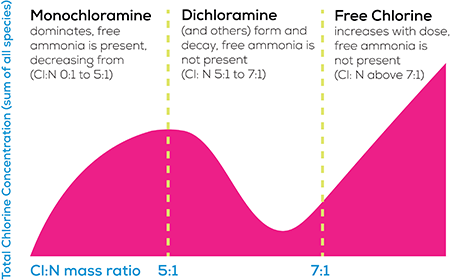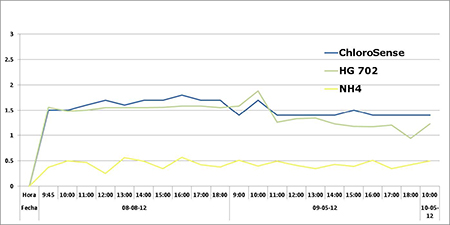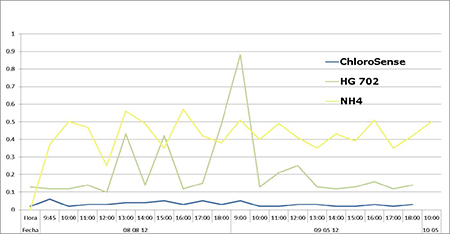Dr Palin developed the DPD method of measuring free and total chlorine in the 1950’s and described at the time how the colorimetric method can suffer from interference from monochloramine during free chlorine readings. One of the largest providers of potable water in Spain has experienced these difficulties in controlling their chemical dosing in chloraminated water. They found sporadic spikes in their free chlorine concentration that they suspected may be caused by monochloramine.
Chloramination is often used as a disinfectant method when there is a large distribution network, as it provides a more prolonged disinfection compared to free chlorine.
Chloramines are usually formed by adding ammonia to water containing free chlorine (HOCl- or OCl-, depending on the pH) in a particular ratio (usually chlorine:ammonia 5:1). When the reaction takes place, three kinds of inorganic chloramines can be formed; monochloramine; dichloramine and trichloramine. Which form is predominant within the solution is dependent on the chlorine:ammonia ratio, the pH of the solution and the contact time. The ideal pH value for the production of monochloramines in this reaction is 8.4.

The Problem
Traditionally, DPD (N,N Diethyl-1,4 Phenylenediamine) chemistry has been used to monitor free chlorine and chloramines. This can lead to confusion within the distribution network as the DPD method for determining free chlorine can suffer interference from monochloramine. This is known as 'breakthrough' and is when monochloramine breaks into the free chlorine fraction. The rate of breakthrough is affected by pH and temperature and is often witnessed as a slow increase in the free chlorine value, whilst not affecting the total chlorine reading.
At Palintest, DPD tablets are controlled so that they do not suffer excessive breakthrough when testing chloramine solutions, however some interference (<5%) still exists. The utility used an online monitoring system based on the DPD colorimetric method and frequently found fluctuations in their free chlorine measurements, which they suspected were related to breakthrough.
The Solution
The ChloroSense instrument uses a patented electrochemical method known as chronoamperometry, combining an instrument and disposable sensors for the simultaneous measurement of free and total chlorine. When the sensor is immersed in the test solution, chlorine will react with the reagents on the free chlorine electrode and chlorine and chloramines (total chlorine) will react with the reagents on the total chlorine electrode.
The Results
The ChloroSense was used alongside a DPD colorimetric on-line system on an hourly basis over two days within their distribution network, to determine the performance of two methods in the chloraminated water.
The graph shown below demonstrates that both the ChloroSense and the online DPD based method gave similar total chlorine readings across the test period around the expected 1.5 mg/L dose.
Total Chlorine

Free Chlorine

Conclusions
With high levels of ammonium (NH4) and free chlorine being dosed into the network, the utility expected to see a low free chlorine residual and a total chlorine response of approximately 1.5 mg/L. The on-line DPD method struggles to monitor the free chlorine residual accurately whilst performing well when testing total chlorine.
The ChloroSense results show that breakthrough is not an issue with the chemistry used on the sensor. Free chlorine residuals are monitored as below 0.05mg/l over the two day testing period. The total chlorine results show the ChloroSense matches on the on-line analyser.
In summary, for applications where chloramination is being used, using DPD chemistry to monitor free chlorine residuals can be difficult - a skilled operator is called for. For applications where breakthrough is an issue, ChloroSense can provide the solution.